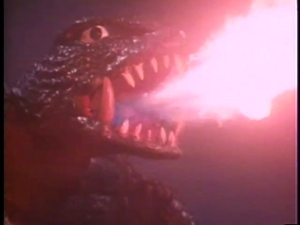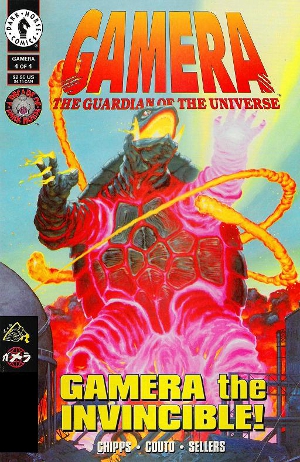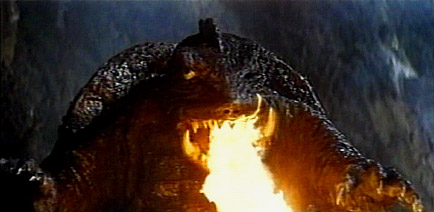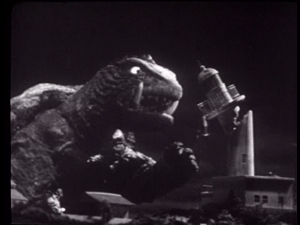Tag Archives: Daiei
Gamera vs. Viras (1968)
Gamera vs. Gaos (1967)

This is the exact midpoint of Gamera’s original (or “Showa Era”) film series. Not chronologically, or in any other terms material, but in terms of tone. This is the point where everyone at Gamera’s home studio, Daiei Film, gave up on the daikaiju genre as anything other than a cash cow. You can barely blame them. By 1967, the writing was on the wall and it said, “the only people stupid enough to abandon their TVs and visit some run-down, overcrowded, food-and-drink-stained movie theater are children.” Film as a whole suffered, but few suffered more than our favorite flying turtle, who would go on to star in some of the most notoriously bad films in daikaiju eiga as the seventies rose up to choke us all down with mediocrity, bad music, and even worse clothing.
Things didn’t have to be this way, but the makers of mid-60s Japanese cinema made the same mistake their American counterparts so often make and assumed (A) kids were the only ones watching their films and (B) kids were stupid. But there’s a difference between being stupid and not being able to articulate why you like something. My ten-year-old self knew Gamera was awesome on a molecular level but my current self still struggles to articulate why that is. Why do you think I’m writing these things in the first place? To finally pull back the curtain and figure out why, whenever someone goes, “Gamera? Really?” I always go “Fuck yeah, Gamera! He’s awesome.”

His movies, on the other hand, stopped being the “unbelievable, imaginatively cool” kind of “awesome” and started being the “incredibly cheap and incredibly crappy” kind of “awesome” right in the middle of this film. I can even show you where it happens: it’s the scene where Our Kenny – an incredibly annoying little snot named Eiichi (Naoyuki Abe) – takes a joyride on Gamera’s back. Continue reading Gamera vs. Gaos (1967)
Gamera vs. Barugon (1966)
 Gamera vs. Barugon is the high point of the original Gamera franchise. After the (relative) success of Daikaiju Gamera, the far-sighted and responsible men of Daiei Studios could have carried on, as their fellows at Toho have for years, mining the tried and true formulas of the giant monster genre to wildly varied, but none-the-less consistent, success.
Gamera vs. Barugon is the high point of the original Gamera franchise. After the (relative) success of Daikaiju Gamera, the far-sighted and responsible men of Daiei Studios could have carried on, as their fellows at Toho have for years, mining the tried and true formulas of the giant monster genre to wildly varied, but none-the-less consistent, success.
But the times were, sadly, a’ changing. Those who pine that American cinema is slave to every idiotic trend that comes down the pike obviously haven’t watched enough Japanese monster movies. They provide quite the handy cultural history of Japan, and can be enjoyable on that level even if one has no interest in giant monsters (narrow minded philistine that you are). {More}
Gamera 3: The Revenge of Iris (1999)
 Until 1995, Gamera was the joke: about as low as you could go in the land of Giant Monsters…unless you went to the real out-of-the-way backwaters, like Hong Kong, or South Korea. He was, at best, a Godzilla rip-off, and even nerds like us look down on those. The fire-breathing clown palled around with the kids when he should have been out handing Tokyo its ass. Oh, sure, he saved the world…but from what? A giant salamander with an opal fetish? A telepathic shark from Outer Space? A star fish? I mean, c’mon. Even the Flash has better villains.
Until 1995, Gamera was the joke: about as low as you could go in the land of Giant Monsters…unless you went to the real out-of-the-way backwaters, like Hong Kong, or South Korea. He was, at best, a Godzilla rip-off, and even nerds like us look down on those. The fire-breathing clown palled around with the kids when he should have been out handing Tokyo its ass. Oh, sure, he saved the world…but from what? A giant salamander with an opal fetish? A telepathic shark from Outer Space? A star fish? I mean, c’mon. Even the Flash has better villains.
It was easy to pick on Gamera. It was fun. Not so easy any more. Because Gamera has become the pinnacle. The new high water mark in giant monster cinema. In Gamera 3, the wave broke, just in time for the Millennium. Remember when the world ended? Yeah, so do I. Remember how seriously we all took that? As if it actually mattered? Well, imagine how it felt to our Japanese brothers and sisters. There’s a palatable sense of impending doom throughout Gamera 3, adding weight and drama to the proceedings and turning this story (and its giant turtle protagonist) into more than the sum of their rubbery parts. {More}
Gamera 2: Advent of Legion (1996)
 A large meteor
A large meteor
Falls to Earth near Sapporo
Then the fun begins
As far as director Shusuke Kaneko is concerned, “Gamera 2 focuses on the war aspect of giant monsters.” A “kaiju big battle” is, for once, the main focus of a giant monster film. How revolutionary. There’s nary a moment spared for the idiotic, soul-searching “character moments” that usually clutter these types of movies. This is a textbook case of good monster moviemaking, some of the best you’ll find on either side of the pond. And you can quote me on that. Not that you will, but whatever. The point is, against all odds, Kaneko and co. have taken the silliest big-budget monster in Japan’s vast Popular Culture and transported him into a serious film.
As I mentioned in the haiku, a swarm of meteors fall on Japan’s northern-most island, Hokkaido. One lands almost directly on top of Science Center Teacher/Technician/All-Around Girl Honami Midori (Miki Mizuno) and her brace of kids. Military personnel arrive the next day only to find the meteor gone, without so much as a note on the pillow. The military, commanded by Colonel Watarase (Toshiyuki Nagashima), scratch their collective heads in dismay. You think they might want to call a Scientist in on this? {More}
Gamera: Guardian of the Universe (1995)
 Looking back, Gamera’s rebirth was almost inevitable. History repeats itself and the movie industry eats its dead. Inspired by the success of the modern Godzilla films (beginning with 1984’s Godzilla and ending, on a dower, cliffhanger-note in 1995’s Godzilla vs. Destroyah), Daiei brought their own terrible terrapin out of retirement exactly nine months before Godzilla’s (latest) death. In black and white, as I’ve mentioned, Gamera can be somber, dynamic, dark…creepy in his own, lantern-eyed way. But the advent of cheap color film technology was no friend to the Friend to Children Everywhere.
Looking back, Gamera’s rebirth was almost inevitable. History repeats itself and the movie industry eats its dead. Inspired by the success of the modern Godzilla films (beginning with 1984’s Godzilla and ending, on a dower, cliffhanger-note in 1995’s Godzilla vs. Destroyah), Daiei brought their own terrible terrapin out of retirement exactly nine months before Godzilla’s (latest) death. In black and white, as I’ve mentioned, Gamera can be somber, dynamic, dark…creepy in his own, lantern-eyed way. But the advent of cheap color film technology was no friend to the Friend to Children Everywhere.
Like the daikaiju genre as a whole, by the 1970s, Gamera grew down right silly. After all, we are talking about a giant, fire-breathing turtle who flies by projecting jets through his shell’s arm- and leg-holes. (Of what? Don’t ask. My sainted father always assumed it was flatulence. ) Thankfully, the makers of Guardian of the Universe made the informed and, dare I say it (dare, dare), enlightened decision to treat Gamera seriously. Whatever the shortcomings of the Heisei Godzilla series, they were never less than serious films, susceptible to all the snares and pitfalls of the Action/Adventure pictures they emulated. Guardian of the Universe, for the most part, avoids these thanks to its narrower focus. It wants (insomuch as a film can want anything) to be only what it is: the perfect giant monster picture, complete of its kind. {More}
Gammera the Invincible (1965)
 Though he began life as a humble Godzilla rip-off in a land and time glutted with them, Gamera would come to symbolize everything that went so horribly wrong with the Golden Age of daikaiju cinema. But let us not tell sad stories about the death of kings just yet…like his more famous cousin/industrial competitor, Gamera began life as a serious apotheosis of the paranoia and insecurity of his age. But even here, at the beginning, we can see his creators at Daiei Studios sowing the seeds of their creation’s destruction.
Though he began life as a humble Godzilla rip-off in a land and time glutted with them, Gamera would come to symbolize everything that went so horribly wrong with the Golden Age of daikaiju cinema. But let us not tell sad stories about the death of kings just yet…like his more famous cousin/industrial competitor, Gamera began life as a serious apotheosis of the paranoia and insecurity of his age. But even here, at the beginning, we can see his creators at Daiei Studios sowing the seeds of their creation’s destruction.
And speaking of destruction…it’s 1965 again, and despite rising tensions between the Superpowers, someone’s still managed to scare up the funding for an Arctic expedition (chasing that fabled Northwest Passage, no less). As the film opens, the expedition’s official zoologist, Dr. Hidaka (Eiji Funakoshi), his typically hot assistant, Kyoke (Harumi Kiritachi), and your standard news hound, Aoyagi (Junichiro Yamashiko), stop by an Eskimo hut to warm up and quiz the natives. A formation of toy planes interrupts their welcome. “Russian planes,” Hidaka says. {More}
